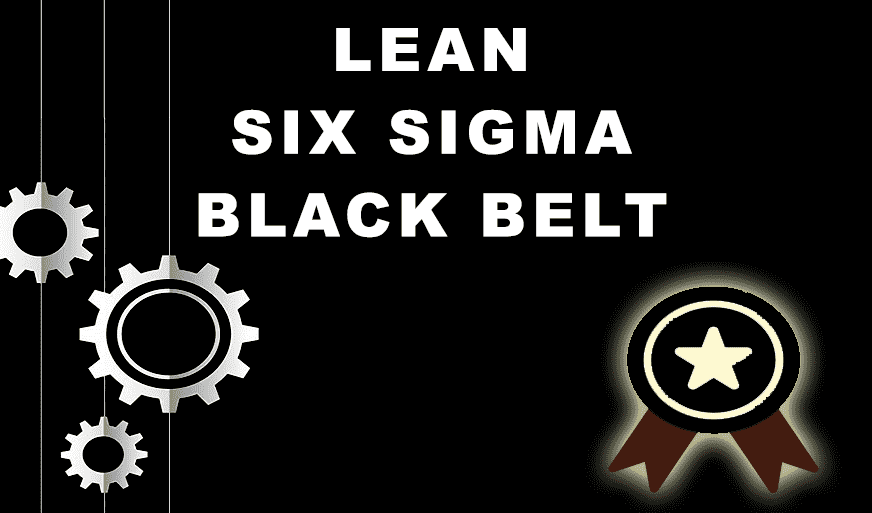Six Sigma Interview Questions and Answers 2024
-
 By Syed Irfan
By Syed Irfan - Published on Nov 10 2023

Table of Contents
- Most Commonly Asked Six Sigma Interview Questions and Answers 2024
- Scope of Six Sigma Certified Professionals
- Top Six Sigma Interview Questions and Answers
- Most Asked Six Sigma Interview Questions and Answers
- General Six Sigma Interview Questions and Answers
- Fundamental Six Sigma Interview Questions and Answers
- Black Belt Six Sigma Interview Questions and Answers
- Green Belt Six Sigma Interview Questions and Answers
- Yellow Belt Six Sigma Interview Questions and Answers
- Practice Interview Skills with Sprintzeal's Six Sigma Certification
- Key Takeaways
- FAQs
Most Commonly Asked Six Sigma Interview Questions and Answers 2024
In 2024, when you're interviewed for a Six Sigma job, you'll likely face some common Six Sigma interview questions. They usually ask about your knowledge of Six Sigma basics, like how you improve processes and use data for decision-making.
They might want you to explain the DMAIC methodology, which is all about solving problems step by step. They could also ask about your experience in different Six Sigma roles, such as Green, Black, or Yellow Belts.
Expect Six Sigma interview questions about how you've used Six Sigma tools to solve real problems. Being ready for these questions is crucial to show you know your stuff and can excel in Six Sigma jobs.
Understanding the Six Sigma Paradigm
We're starting with a strong note to show what employers expect from their employees, especially regarding payroll and benefits. Benefits like sick time may vary based on your eligibility. Different generations, such as Generation X, Millennials, and Generation Z, receive different benefits.
For instance, Generation X may get extensive packages and pension benefits not seen with younger professionals. Understanding these generational differences in the workplace is crucial for reducing turnover and establishing industry benchmarks.
Harvard University's report highlights a difference in employee and employer perspectives on job motivators, with compensation ranked differently.
We'll focus on manufacturing and production trends, especially relevant for Six Sigma certification holders who often work as engineers or plant supervisors. However, Six Sigma certification's applicability extends beyond production; it's valuable for HR, finance, marketing, and PR departments. This article will guide you on answering challenging and straightforward questions to impress hiring managers and decision-makers.
Scope of Six Sigma Certified Professionals
A mechanical engineer with a Six Sigma certification can earn more than $75,870 per year. Tom word same goes with a manufacturing manager who can earn $70,000 per year. Out of this certification, the most is earned by the quality manager with a staggering salary of $80,000 per year.
With your seniority and involvement in different kinds of projects, your salary ceiling is increased gradually. We have segregated the top six sigma interview questions and answers for the respective questions and most asked six sigma interview questions.
Top Six Sigma Interview Questions and Answers
Here is a list of the latest Six Sigma interview questions and answers, ideal for those looking to prepare for six sigma questions for interview.
1) What do you mean by six Sigma and elaborates its principles?
Six Sigma is a data-driven methodology for process improvement. Developed by Bill Smith, a Motorola plant manager in 1986, it aims to boost quality by minimizing defects and inefficiencies. The key concept is "defects per million opportunities," calculated as defects divided by sample size. It draws from work-study, process control, and Pareto's 80/20 rule.
Notably, Six Sigma complements various other principles like Kaizen, Kanban, Lean, and Agile. It bridges the gap between desired and actual product quality while reducing costs. The versatility of Six Sigma makes it compatible with many other productivity-enhancing concepts, demonstrating its broad applicability in enhancing processes and products.
2) Define DPMO or DPPM?
DPMO Stands for defects per million opportunities, while DPPM stands for defective parts per million. When we consider the flow of the production in any given industrial unit or production unit, we find that quality is often compromised due to many reasons, and one is ineffective training given to the Labour force.
The companies, as well as industries, focused more on productivity by engaging the Labour force in committing to their work as per the piece which system. And this is the reason that often the quality is compromised in order to gain maximum outputs in the shorter time possible. The concept given by the six Sigma is to constantly maintain the paradigm in which factors like time as well as quality are crucial. So, a production manager is responsible for sketching an achievable target with optimized cost maintaining the Labour compensation. From a customer's perspective, it runs a feedback loop in which likes and dislikes of the end-users are considered, and a middle path is found that is inculcated in the production to gain brand loyalty.
3) What are some of the quality management tools in Six Sigma?
There are many quality management tools that are included in Six Sigma. Some of them are,
- Cost-benefit analysis
- CTQ tree
- SIPOC analysis
- COPIS analysis
- Taguchi Methods
- 5S
- Seven Wastes
- Value stream mapping
- Visual workplace & quality function deployment
4) List out the different kinds of variations used in six Sigma?
In Six Sigma, various types of variations are utilized, including mean, median, range, and mode. Data collection begins with a clear understanding of factors affecting it. Data is categorized into two main types: quantitative (from continuous data) and qualitative (from discrete data). A measurement system analysis checks the validity of the company's measurement system. Mean, median, range, and mode play a significant role in this analysis.

5) What do you mean by gauge R&R?
When we are concerned about repeatability and reproducibility, then we use gauge R&R to describe the difference between repeatability and reproducibility. We shift our focus on the P -values and, if not the normal values, and try to make the box-Cox transformation as accurate as possible.
6) Find the value stream mapping?
The common misconception about value stream mapping is that it is often related to lean six Sigma; however, this is entirely different from six Sigma process mapping. The value stream mapping helps us to understand the current state by identifying the start and the endpoint of every process. Further, we have to draw the process flow mapping the process is including all the sub-steps into one unit that has metrics for each process step.
In the next step, we analyze and reflect the current state value stream map with all the stakeholder's expectations. Basically, here we find the root cause of the limitation, a cost-effective solution that is needed to be developed. By looking at the value that weird redelivering currently and waste we are incurring can help us calculate the touch time or the cycle time.
Then we work on improving the slowest throughput or cycle time by implementing the future stated value stream map and socializing consensus from all the stakeholders again. In this way, we optimize the whole and not a single process that also gives us a chance to sustain in aggravating new standards and establishing measured performance related to the cost parameters. This reinforcement is monitored on a continuous basis.
Most Asked Six Sigma Interview Questions and Answers
Below are the Six Sigma interview questions and answers that are frequently asked:
7) What is the ISHIKAWA diagram?
We can note that there are different steps and processes involved where quality control is an issue and arises time and again with specific requirements. With the help of the Ishikawa diagram, we are able to direct the casual factors into a final outcome by shipping somewhat like a fish, and that is sometimes called a FISHIKAWA Diagram.

This is also known as a fishbone diagram or cause and effect diagram. It displays various causes of an event, listed on the "skeleton" with "ribs" representing these causes, such as methods, machinery, management, materials, and manpower. All the effects are shown at the "head" of the fish. The purpose of this diagram is to help management identify urgent issues and those to consider for the future. To create an Ishikawa diagram, gather a group to discuss and document the problem statement. This brainstorming helps categorize the causes and choose the best actions to address them.
8) How would you define the Alpha and beta risk?
To understand the concept of Alpha and beta risk, we need to close leave understands the pea value in closer details. When the P-value is more than 0.05 or 5%, then it is defined as H 0. If the pee value is lesser than this, then it is called Ha. the concept of the value runs on probability, but when we proceed with 95% of confidence with the sample, then we are prone to risks of 5%.
Now, if the P-value is more than 5%, then the risk is on the higher side making consequences unacceptable if not dealt with immediately. The higher risk is defined as the Alpha risk well; the lowered risk is called beta risk.
9) how would you define an affinity diagram?
This is an analytical tool that is used to organize ideas into subgroups by having a common theme of relationship to develop solutions after brainstorming. To proceed with this, we need to have an affinity group who quietly puts their ideas of operative quality and initiates the brainstorming session. Then all the solutions given by the group are aligned and segregated into homogeneous groupings with affinity headings above it. And in this way, the candidate visualizes the solutions and list their numbers accordingly.
10) What are the different quality levels of six Sigma?
The methodology of Six Sigma is developed on measuring the quality of a process, and at every Six Sigma level, correspondence is achieved to several acceptable defects per million or to the extent that is optimum to six Sigma. The optimum six Sigma level, which is to be achieved, goes by 3.4 defects per million opportunities. This number gives us a general overview of the output levels.
One defect in every 69,0000 articles or outputs is permissible, whereas two defects in every 308 537 outputs are permissible with three defects in 66807 outputs are permissible. While the six Sigma considers four defects in every 6210 output are normal and five defects in every 233 outputs to be normal. This, if so, the window for six defects in every 3.4 outputs.
General Six Sigma Interview Questions and Answers
Here are the general Six Sigma interview questions and answers:
1) Define the Kano Model?
This model is used to identify the voice of the customer but helps us to compare the characteristics versus the degree of satisfaction in each delivery. It was invented by Dr. Kano, who has listed five of the following characteristics Toby ascertained in the voice of the customer, and they are as follows;
- Dissatisfying
- Must-haves
- Customer needs
- Delighters
- indifferent
This is a revolution in the service management industry. Professor Noriaki Kano founded this beauty of product development and customer satisfaction in the late 1980s to determine the must be quality, one-dimensional quality, attractive quality, indifferent quality, and reverse quality. These threshold attributes are taken as an output of price of entry to develop strategies that can be recognized through companies' slogans. The idea here is to aggravate functional expectancies of customer satisfaction from dysfunctional to the following categories depending upon the answers our customers have for our future product. We can inculcate online service software, questionnaire, and client interview as a specialized tool for analysis.
2) Define the spaghetti diagram?
A spaghetti diagram is employed to reduce various forms of waste in processes. It targets waste in transportation, motion, and waiting times.
Companies and multinationals are adopting spaghetti diagrams, a part of lean tools, to enhance work layouts, minimize transport-related waste, eliminate non-value items, reduce employee fatigue, and enhance the lean concept's value in the highly competitive business environment.
3) When should we use Kaizen events?
In situations where we need to establish incremental improvement, Kaizen serves as the best solution by bringing quick solutions to two pressing problems that appear to be very significant. This is highly efficient in handling intensive cross-functional collaboration; with a quick solution, we can aggravate improvement in nearly three to five days of implementation.
5) Define control charts?
On six of March, when we need to evaluate the durability of a process over a given period of time, then we use control charts as a tool to graph and state whether the process is scaled between the permissible limits or not.
It adds value to the time and resources of the company by saving additional efforts. Along with control charts, we use histograms to develop and evaluate observations that are helpful in determining the process needs.
6) What, how, and why control is required?
Before we understand the needs for control, we need to understand data projection, continuous use of data, discrete data, and their users in control charts. In Minitab and Nelson's rule, control needs are devised once the improvement is sustained in the due process.
This is usually carried out after the completion of the project so that we can find no prevailing issues. To strengthen control, we need to have information off continuous data and discrete data fed into the control chart. Here box plots and histograms are used for different purposes in differentiating between the control and run chart.
7) Define Pareto chart?
Pareto analysis is a crucial Six Sigma tool that prioritizes issues and defines them clearly. It provides insights into regression and employs chi-square tests for quality improvement momentum.
Pareto charts offers a clear picture of necessary actions considering available resources and costs. This analysis optimizes processes and costs, enabling us to better meet customer needs and outperform competitors. It also enhances stakeholder feedback, ensuring satisfaction.
8) List the lean six Sigma project types?
To be practical or pragmatic in our approach to service delivery, we use lean six Sigma. There are three kinds of lean, six Sigma projects, and they are as follows:
Quick win project: friendly it is called us just do it project this is a plain and painless project as we know the problem and the solution.
Process improvement projects: the peculiarity of this project is that the causes are undefined that is leading to unsatisfactory results. Process improvement projects help us to better bridge this gap of undefined causes an unsatisfactory result.
Designing new projects: as a whole, designing new projects involve the creation of a brand-new process and set the benchmark to compare with the voice of the customer.
Redesigning new process projects: the idea here is to focus more on the overhauling process that is ineffective and re-engineer it how to make it more efficient and customer friendly.
Implementing new infrastructures: this is popularly known as process management, Which helps us to establish key measurement systems in the production as well as the service delivery model.
9) What do you mean by effect size?
When we measure the overall magnitude in quantitative terms, then we use or experiment effect size. This helps us to understand the size of the impact and the relationship it has between other variables.
10) What do you mean by be the value?
Be value is known as the probability value that helps us to determine a result based on the null hypothesis. It helps us to identify the causes of the events in reality and prove the other events that were not responsible for the flash of the results.
The probability value less than .5 is termed as a value that is against the hypothesis. While the probability value greater than .5 has a substantial value for the null have for thesis redirecting us two approaches for an alternative hypothesis. We must understand that calculating the effect size entirely depends upon the probability value, so to understand the overall magnitude we have to keep a balance in the relationship between the given variables and impact it has over the results.
Fundamental Six Sigma Interview Questions and Answers
Here are the fundamental Six Sigma interview questions and answers:
1) What is Six Sigma?
Six Sigma is a highly structured and data-driven methodology that organizations use to enhance their processes and reduce defects. By striving for Six Sigma, companies aim to minimize variations and improve the quality of their products and services.
2) Why is Six Sigma important?
Six Sigma holds great significance as it helps organizations achieve a competitive edge by streamlining processes, reducing waste, and boosting customer satisfaction. It enables businesses to make informed decisions, leading to cost reduction and increased profitability.
3) What are the key principles of Six Sigma?
The key principles of Six Sigma include customer focus, process measurement, analysis, improvement, and control. By adhering to these principles, organizations ensure that their processes consistently deliver high-quality results.
4) Define DMAIC in Six Sigma.
DMAIC is an acronym for Define, Measure, Analyze, Improve, and Control. It's a systematic problem-solving approach used to identify issues, measure performance, analyze root causes, implement improvements, and establish controls to maintain the improvements over time.
5) What is a process sigma level?
A process sigma level is a statistical measure of process capability. It indicates the number of standard deviations that exist between the process's performance and the customer's requirements. A higher sigma level signifies a more reliable and efficient process.
6) What are common tools used in Six Sigma projects?
Common tools used in Six Sigma projects include Pareto charts, control charts, fishbone diagrams, and statistical analysis software. These tools help in data analysis and problem-solving.
7) Explain the role of a Yellow Belt in Six Sigma.
A Six Sigma Yellow Belt is an entry-level role in Six Sigma. Yellow Belts support project teams by assisting in data collection, participating in process improvements, and ensuring that project objectives are met within their specific area of work.
Black Belt Six Sigma Interview Questions and Answers
When preparing for the certification, candidates often encounter a variety of interview questions for Six Sigma Black Belt that assess their knowledge and expertise in process improvement methodologies.
Below are some of the black belt Six Sigma interview questions along with answers:
1) What is the role of a Six Sigma Black Belt?
A Six Sigma Black Belt is a highly skilled professional responsible for leading and managing complex Six Sigma projects. They play a pivotal role in implementing Six Sigma practices within an organization, acting as change agents and guiding project teams.
2) How do you handle resistance to change in a Six Sigma project?
Resistance to change is a common challenge in Six Sigma projects. Effective handling involves transparent communication, involving team members in the change process, and demonstrating the benefits of the proposed changes.
3) What is the difference between a Green Belt and a Black Belt in Six Sigma?
The primary distinction between Green Belts and Black Belts lies in their level of expertise and responsibility. Black Belts possess advanced knowledge and lead larger, more complex projects, whereas Green Belts work on smaller-scale projects as team members.
4) Explain the concept of Lean Six Sigma.
Lean Six Sigma is an integrated approach that combines the principles of Lean and Six Sigma methodologies. It aims to eliminate waste, enhance efficiency, and improve quality in processes, making it a powerful strategy for organizations.
If you're preparing for a Lean Six Sigma interview, you might be interested in understanding the key concepts and techniques related to interview questions for Lean Six Sigma.
5) What is the significance of statistical tools in Six Sigma projects?
Statistical tools play a crucial role in Six Sigma projects as they provide data-driven insights, facilitate root cause analysis, and guide the decision-making process. These tools enable Black Belts to identify opportunities for improvement and monitor progress.
6) What are the phases of a DMAIC project?
DMAIC consists of five key phases: Define, Measure, Analyze, Improve, and Control. Each phase has a specific purpose, and together, they form a structured framework for project success.
7) How can you ensure the sustainability of improvements in a Six Sigma project?
Sustainability is achieved through the implementation of effective control measures, ongoing monitoring of processes, and continuous engagement with stakeholders. This ensures that improvements are maintained over time.
Green Belt Six Sigma Interview Questions and Answers
Below are some of the green belt Six Sigma interview questions and answers for professionals:
1) What is the role of a Six Sigma Green Belt?
A Six Sigma Green Belt plays a critical role in process improvement. They work on Six Sigma projects while performing their regular job duties, collaborating with team members and contributing to the success of projects.
2) How do you select a Six Sigma project for a Green Belt?
Green Belts choose projects that align with organizational goals and have the potential to make a significant impact. Selection criteria include the project's relevance, feasibility, and expected outcomes.
3) Explain the concept of process variation in Six Sigma.
Process variation refers to the natural deviations in a process that can lead to defects or errors. The goal of Six Sigma is to reduce and control this variation, ensuring consistent and high-quality results.
4) What are the basic statistical tools used by Green Belts in Six Sigma projects?
Green Belts commonly use statistical tools such as histograms, scatter plots, process capability analysis, and run charts to analyze data and identify areas for improvement.
5) What is a CTQ (Critical to Quality) in Six Sigma?
A CTQ, or Critical to Quality, is a specific aspect of a product or process that has a direct impact on customer satisfaction. Identifying and addressing CTQs are fundamental to successful Six Sigma projects.
6) How can Green Belts ensure effective teamwork in Six Sigma projects?
Effective teamwork is fostered through clear communication, defined roles, collaboration, and a shared commitment to the project's success. Green Belts should encourage open dialogue and synergy among team members.
7) What are the key benefits of Green Belt Six Sigma certification?
Green Belt certification enhances problem-solving skills, project management capabilities, and overall knowledge of Six Sigma. It positions individuals to contribute to organizational growth and success.
Yellow Belt Six Sigma Interview Questions and Answers
Here are few of the yellow belt Six Sigma interview questions and answers:
1) What is the role of a Six Sigma Yellow Belt?
A Six Sigma Yellow Belt has a foundational understanding of Six Sigma principles and is typically responsible for supporting process improvement initiatives within their specific department or area of work.
2) How can a Yellow Belt contribute to process improvement?
Yellow Belts contribute to process improvement by collecting and analyzing data, participating in process documentation, and offering insights to enhance the performance of their respective work areas.
3) Explain the importance of data accuracy in Six Sigma projects.
Data accuracy is paramount in Six Sigma as it forms the basis for informed decision-making and the identification of root causes. Inaccurate data can lead to misguided efforts and ineffective solutions.
4) What is a SIPOC diagram in Six Sigma?
A SIPOC diagram (Suppliers, Inputs, Process, Outputs, Customers) is a valuable tool used to visually represent the components and interactions within a process. It helps stakeholders gain a clear understanding of how a process works.
5) How can Yellow Belts apply the 5 Whys technique in problem-solving?
Yellow Belts can employ the 5 Whys technique to dig deeper into problems by repeatedly asking "why" to identify the root cause. This method helps in addressing issues at their source.
6) What are some common challenges Yellow Belts may face in Six Sigma projects?
Yellow Belts may encounter challenges such as resistance to change, difficulties in data collection, and resource constraints. Overcoming these challenges requires perseverance and effective problem-solving skills.
7) How can Yellow Belts continuously improve their Six Sigma skills?
Continuous improvement involves learning from experiences, seeking feedback, and staying updated with Six Sigma best practices. Yellow Belts can enhance their skills by actively participating in projects and pursuing further Six Sigma training.
Practice Interview Skills with Sprintzeal's Six Sigma Certification
Sprintzeal offers comprehensive training courses in Green, Black, and Yellow Belt Six Sigma certifications. These courses provide professionals with the knowledge and practical skills needed to excel in Six Sigma projects and interviews.
For those seeking information on Six Sigma Interview Questions, Sprintzeal's hands-on training and certification programs help candidates gain a deep understanding of essential concepts, preparing them for real-world challenges.
Popular Six Sigma Certifications to consider:
Six Sigma Green Belt Certification
Six Sigma Black Belt Certification
Six Sigma Yellow Belt Certification
Lean six sigma green belt certification
Lean six sigma black belt certification
Key Takeaways
The key takeaways from this guide highlight the pivotal role of Six Sigma in achieving process excellence and customer satisfaction. Understanding the levels of certification and the principles of Six Sigma is essential for successful project management.
To get Six Sigma Training and Earn a Six Sigma Certifications, you can chat with our six sigma course expert . We will help you find the certification that fits your career goals
Stay ahead in the world of quality management - subscribe to Sprintzeal's newsletters and free ebooks for insightful updates and expert guidance.
FAQs
How do you explain Six Sigma in an interview?
In an interview, explain Six Sigma as a disciplined methodology that focuses on process improvement, defect reduction, and customer satisfaction through data-driven decision-making and problem-solving.
What are the 6 points of Six Sigma?
The Six Sigma methodology emphasizes six core points: customer focus, data-driven decision-making, process improvement, teamwork, and the use of statistical tools and techniques.
What is a Six Sigma question?
A typical question in a Six Sigma interview often revolves around Six Sigma principles and their application in problem-solving scenarios. Candidates are frequently asked to identify the root causes of process issues and propose effective solutions. For more information on this topic, consider exploring additional Six Sigma Interview Questions to enhance your preparation.
How to pass Six Sigma?
To pass Six Sigma certification exams, candidates should undergo relevant training, understand the Six Sigma methodology, gain practical experience through real-world projects, and prepare thoroughly for the certification exams.
Subscribe to our Newsletters
Popular Programs
Trending Posts
What Is Lean Manufacturing?- An Overview
Last updated on Nov 6 2023
Quality Assurance vs Quality Control
Last updated on Aug 2 2023
Best Six Sigma Books in 2024
Last updated on Apr 26 2023
Lean Six Sigma on Resume for Rewarding Career Benefits
Last updated on Nov 20 2023
Quality Manager Interview Questions and Answers for 2025
Last updated on Feb 10 2025
Top 30 Quality Analyst Interview Questions and Answers 2025
Last updated on Feb 20 2025
Categories
- Agile Management 54
- AI and Machine Learning 42
- Big Data 53
- Business Management 51
- Cloud Computing 44
- Digital Marketing 56
- Information Security 8
- IT Hardware and Networking 17
- IT Security 103
- IT Service Management 29
- Leadership and Management 1
- Microsoft Program 2
- Other 43
- Programming Language 31
- Project Management 162
- Quality Management 75
- Risk Management 8
- Workplace Skill Building 2
Trending Now
Top Career benefits of Lean Six Sigma Green Belt
ArticleLean methodology, Six Sigma methodology and Lean Six Sigma Explained
ArticleSix Sigma Black Belt Certification – Value and Career Benefits in 2024
ArticlePareto Chart in Six Sigma - Explained
ArticleQuality Management Interview Questions 2024
ArticleSix Sigma Certification Guide - A Professional's Guide
ArticleSix Sigma Yellow Belt Certification - Six Sigma for Beginners
ArticleQuality Control Explained – Six Sigma
ArticleTotal Quality Management - A Complete Guide for Beginners
ArticleQuality Assurance in Six Sigma Explained
ArticleQuality Assurance vs Quality Control
ArticleSix Sigma Certification – Everything you Need to Know About Getting Certified
ArticleLean Six Sigma on Resume for Rewarding Career Benefits
ArticleQuality Manager Interview Questions and Answers for 2025
ebookService Delivery Manager Interview Questions and Answers (With Examples)
ArticleHow to become a Quality Analyst
ArticleA Supply Chain Management Guide to Mastering Logistics End to End
ArticleSenior Quality Manager Interview Questions and Answers 2024
ArticleTop 30 Quality Analyst Interview Questions and Answers 2025
ArticleFinancial Analyst Interview Questions and Answers 2024
ArticleRisk Manager Interview Questions and Answers 2024
ArticleCompliance Manager Interview Questions and Answers 2024
ArticleOperation Manager Interview Questions and Answers
Article5 Lean Continuous Improvement Principles to Supercharge Your Operations
ArticleHow to Become a Quality Manager - Career, Job Scope and Certifications
ArticleEssential Components of a Quality Management System
ArticleSix Sigma Certifications - Reasons Why you Should Get Them
ArticleTop Qualities of a Good Manager and a Leader
ArticleLearn about Statistical Process Control (SPC) and its top applications
ArticleCost of Poor Quality - A Detailed Guide
ArticleImplementing 5S Methodology for Better Work Efficiency
ArticleWhat Is Lean Management?
ArticleBest Six Sigma Books in 2024
ArticleLeadership vs Management - The Ultimate Guide
ArticleQuality Assurance Plan - Six Steps To Quality Assurance Plan
ArticleOperational Planning Creation, Key Elements and its Benefits
ArticleA Complete Guide to Product Life Cycle Stages 2025
ArticleSix Sigma tools for DMAIC Phases
ArticleWhat Is Lean Manufacturing?- An Overview
ArticleThe Lean Continuous Improvement Model: A Comprehensive Guide
ArticleDMAIC vs. DMADV: Key Differences and Choosing the Right Six Sigma Methodology
ArticleA Deep Dive into the Power of Lean Continuous Improvement Process
ArticleLean Continuous Improvement Methods for Business Excellence
ArticleIntroduction to Lean Manufacturing- Definitions, Framework, and More
ArticleUnderstanding the Key Principles of Lean Manufacturing
ArticleSecret to Unlock Organizational Excellence: Stages of Continuous Improvement
ArticleLean Continuous Improvement: A Detailed Guide to Mastering Organizational Quality
ArticleLean Waste Management: The Ultimate Guide 2023
ArticleA Deep Dive into Lean Continuous Improvement Tools
Article8 Wastes of Lean - Strategies for Identification and Elimination
ArticleThe Ultimate Guide to Lean Manufacturing
ArticleUnderstanding Lean Manufacturing's Pros and Cons
ArticleLean Waste Reduction Strategies: Boost Efficiency and Cut Costs
ArticleTop 10 Lean Manufacturing Tools for Optimal Productivity
ArticleBeyond the Basics: Benefits of Lean Continuous Improvement
ArticleWhat are Quality Standards? | A Guide to ISO Standards
Article7 Important Types of Quality Management System
ArticleA Comprehensive Guide to Quality Management Systems
ArticleISO 9001 Standard: Benefits and Certification
ArticleBenefits of QMS Certification for Your Business
ArticleStep-by-Step Implementation Guide to ISO 9001
ArticleThe Ultimate Guide to ISO 9001: Boosting Quality and Certification Success
ArticleQuality Management System – QSM Approaches and Methodologies
ArticleHow to Effectively Implement a Robust Quality Management System?
ArticleExplaining QMS Documentation Structure: Benefits and Best Practices
ArticleWho Needs ISO 9001 Certification and Why?
ArticleKey Elements of ISO 9001:2015 Quality Management System
ArticleOvercoming Common Challenges in ISO 9001 Certification: Tips and Best Practices
ArticleBest Quality Management Tools
ArticleTotal Quality Management (TQM) vs. Six Sigma
ArticleQuality Manager Salary: What Freshers & Experts Earn in 2025
ArticleCertified Scrum Product Owner: Job Roles And Responsibilities
ArticleTips for Continuous Integration Testing: Streamlining QA
Article10 Quality Management Strategies Adopted by Top Managers
Article


















